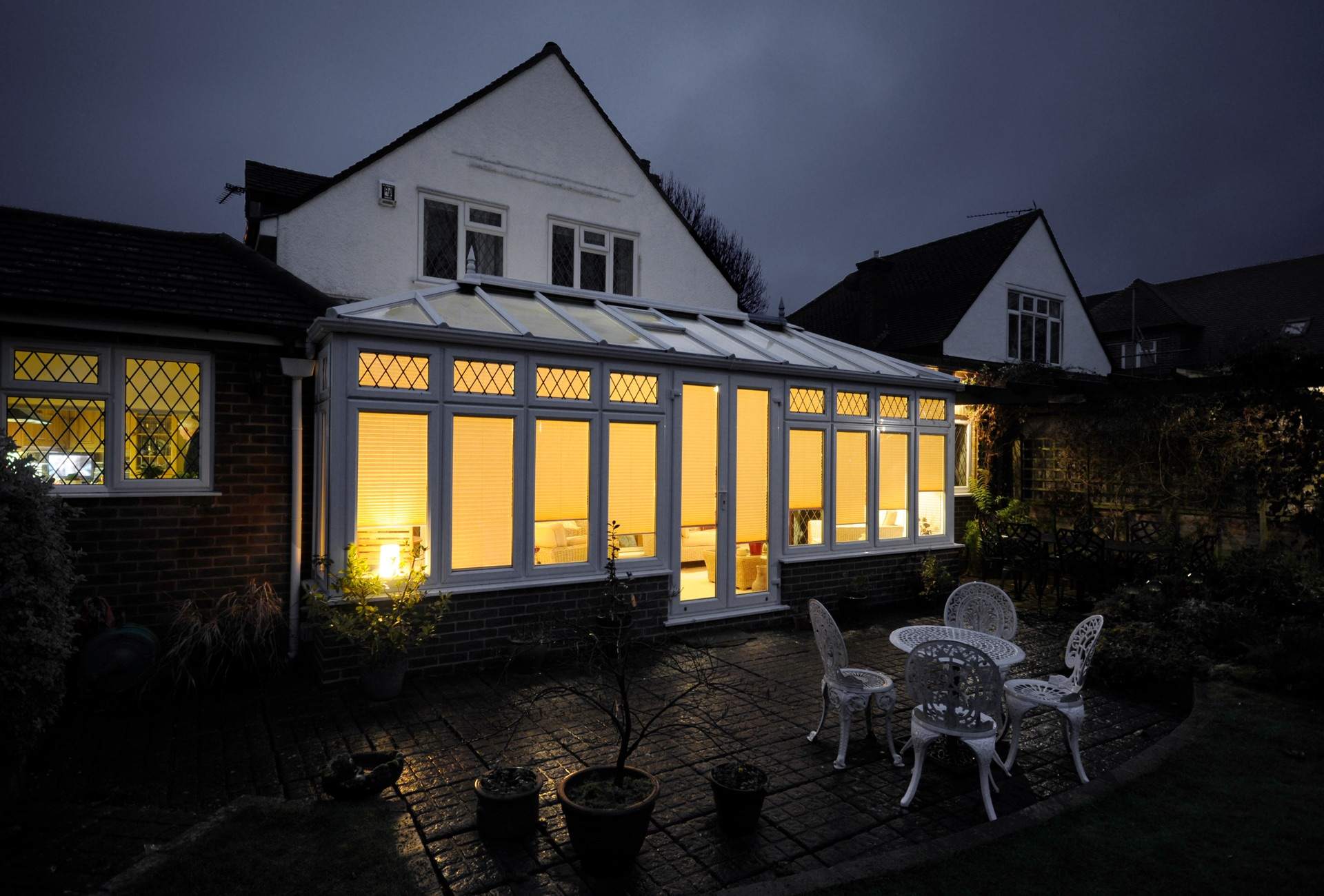GENERAL PRODUCT INFORMATION
Click the headings to view all questions. Click the questions to view the answers.
Pleated blinds are by far the most popular type of conservatory blinds for modern conservatories, of which both our pure™ Pleated Blinds and the Duette® Pleated Blinds are the most popular ranges.
Pinoleum Blinds are the next most popular type of conservatory blinds, probably because they are often the best choice in many timber conservatories.
The blind range that offers the best value for money in a conservatory would be our pure™ pleated blinds – they offer an excellent compromise between cost, and suitability. Our pure™ Pleated Blinds have been specifically designed for use in conservatories, while also not being the most expensive option.
Purely basing it on the cheapest cost (irrespective of value for money) then the cheapest conservatory blinds (where you can have roof and window blinds) would be the Classic Pleated Blinds or possibly Roller Blinds, however neither of these options are really suited for use in a conservatory – they only exist as budget options.
The cheapest side blinds of all are probably vertical blinds, but these are also not designed for conservatories and obviously they are not available as roof blinds.
Yes, we sell a number of blind ranges that utilise “push fit” clips for UPVC windows with neoprene glazing gaskets including Perfect Fit blinds and Tru Fit blinds, so that you do not normally have to fit them using screws (although this is sometimes inevitable depending on your conservatory).
Perfect Fit window blinds offer the advantage of being relatively easy to measure and fit yourself, plus they can actually close off a little more light around the edges compared to standard pleated blinds, venetian blinds and roller blinds, but they are not always recommended in conservatories.
Yes, it is actually one of our specialist areas of expertise.
Although we offer the widest range of standard colours, textures and finishes in the UK, we also offer custom coloured woods, rails and hardware, as well as custom coloured pleated fabric for very large orders. Unlike any other blind company we actually have our own in-house custom finishing facility where we have powder coating facilities (for colouring aluminium rails and components) as well as a full spray shop for custom painting wood rails and components, as well as one-off plastic components.
Obviously any custom-coloured orders take additional time to complete and have an additional cost (which varies with the specification) especially if we have to send you any colour samples for approval, so please bear this in mind when ordering.
We do not normally recommend custom painting UPVC components as, despite the most modern etching materials, it is not possible to guarantee the finish. We nearly always suggest that you choose UPVC components from one of the 9 standard UPVC colours that we use for our pure™ Conservatory Blinds, as they often coordinate well with most custom coloured rails.
Wood finishes can be specified by a BS colour or paint name from the Dulux or Farrow & Ball™ paint ranges. Aluminium components can be specified by RAL code. Pleated fabrics are specified by pantone colour.
Please contact us if you have a specification in mind and we will do our best to assist you
There are huge difference in quality between different blinds and their suitability within conservatories. Look at the detailed information and compare conservatory blinds to see how some blinds are much better in certain situations, but not in others.
Then compare how blinds should look to how they are often fitted if you aren’t careful.
First consider the intended design of the blinds. Many blind are designed for domestic household use to provide basic shade and privacy. They can be used in a conservatory, but will not have anywhere near the desired effect.
Next is the manufacturing quality. As you will see, older blind systems are much less refined and have little attention to detail compared to purpose-designed blinds.
Then there is the quality of workmanship, which can make or break the whole order. It is quite possible for someone with very high standards of workmanship to do an excellent job with a basic blind system. Equally it is very common to see a very poor job carried out, despite a reasonable blind system being specified.
Quality is not just about the manufacturing, but also about the quality and accuracy of installation, all of which is subject to the suitability of the blinds in the first place.
Unfortunately some retailers are more interested in getting your order rather than recommending the most suitable blinds for your requirements. In many respects you cannot be 100% sure of the quality you will receive until your blinds are actually fitted, although you can limit the risk by looking more deeply into the details before you buy. View images that demonstrate that not all conservatory blinds are the same.
When quality is a major consideration you should only consider purpose-designed conservatory blinds – that is to say blinds that were designed specifically for conservatories, rather than general purpose blinds that can be used in a conservatory. The difference in their fitted appearance, performance and operation is significant.
In general terms, the cheapest blinds are very limited in respect of how they look, fit and operate compared to more expensive shaped blinds.
You need to look out for fixed or non-operational blinds, blinds with large apexes at the top, or extra rails to separate the shaped area from the rectangular area in order to make the blinds move.
Most blind retailers cannot make shaped blinds for conservatories at all – many can make some shapes but they are unsuitable and have limitations. In our opinion, if a company cannot make and install blinds professionally into a shaped conservatory without having to exaggerate its abilities, then it cannot call itself a conservatory blind specialist.
Find out more about how our unique shaped roof blinds make all the difference.
Pleated blinds are by far the most popular type of conservatory blinds for modern conservatories, of which both our pure™ Pleated Blinds and the Duette® Pleated Blinds are the most popular ranges. Pinoleum Blinds are the next most popular type of conservatory blinds, probably because they are often the best choice in many timber conservatories.
While we do sell both Perfect Fit and Tru Fit blinds, both of which can be used as DIY blinds, we don’t recommend DIY blinds for conservatories and we won’t supply the blinds without also fitting them ourselves.
Folding door blinds need to be fitted between the glazing beads so that they don’t project out and stop the doors closing properly. Folding door blinds also need to neatly fit with no unsightly clips or frame that will discolour.
For that reason, we recommend either our range of pure™ Pleated Blinds, or the Duette® Pleated blinds are we able able to fit both of these types of blinds neatly into each panel of a set of folding doors.
Folding door blinds will inevitably get wet from occasional rain and dirty because of the through draft from the garden and so need to be washable and water resistant as well as UV stable (including the fabric and components).
Tru Fit blinds are also an alternative option for folding door blinds, providing a cheaper solution.
Our pure™ pleated blinds are ideal conservatory roof blinds, as they offer the neatest fit and can be made to fit into even the more unusual shapes that can be found in a conservatory roof.
Duette® roof blinds are ideal for conservatories with large areas of rectangular glazing, and their honeycomb structure makes them excellent at improving insulation.
Our pure™ Pinoleum blinds are a popular choice for timber conservatory roof blinds and come with an optional solar lining for those looking to reduce heat gain.
Blinds for Conservatory windows provide privacy and a feeling of security in your conservatory, especially at night, but they also improve the appearance of your conservatory. In fact, with careful selection conservatory window blinds can even make it seem bigger.
The blind ranges we recommend for conservatory windows are:
Our unique pure™ Pleated Blinds. Ideal for all conservatory shapes and makes, our pure™ Pleated Blinds can be neatly recess-fitted into the frame of the windows, so they have minimal gaps to let in heat and light.
The Duette® Pleated fabrics are also popular in conservatory windows. Their honeycomb construction makes them excellent insulators, and can be fitted as free-hanging blinds using either SmartCord® or LiteRise® child-safe operation.
Our pure™ Pinoleum Blinds are an excellent choice for timber conservatory window blinds, especially when used in conjunction with pure™ Pinoleum Roof Blinds.
We also offer the Vision® range of premium window blinds – both of which allow you to move between a semi-transparent and dim-out alignment.
Gable blinds can present a problem, especially if you want them to be fully retractable.
Traditionally the solution has been to use roof blinds (which have wires fixed across the glazing) or a retractable corded blind that needs to be tied off on a cleat (very messy and unsafe but also leaves an unsupported area of fabric hanging down).
We have developed our own range of gable blinds that can neatly fit into the space with just two blinds, and can be controlled using our ranges of pure™ Remote Control systems. They can be used with both pure™ Pleated and Duette® fabrics, and retract away neatly so they don’t get in the way.
It depends on the size and style of the skylight. For a standard smaller skylight – essentially a small square or rectangle window in the roof – we would be unable to provide blinds.
However for larger “lantern style” roofs, which are sometimes referred to as ‘skylights’, we are able to both make and fit blinds either horizontally across the bottom of the lantern, or recess fitted to each pane of glass.







